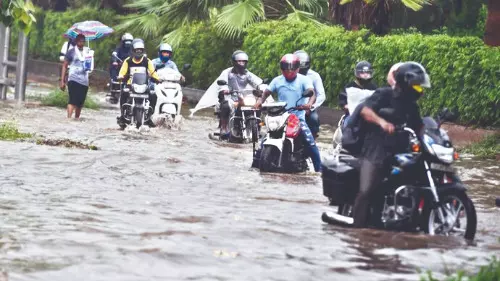Govt likely to set up wireless camps to keep streets dry, residents hopeful but skeptical

New Delhi: In a bid to stay ahead of the monsoon mayhem, the Delhi government is preparing to roll out wireless base camps equipped with cutting-edge communication tools to tackle urban flooding and waterlogging. This proactive step comes in the wake of heavy waterlogging incidents in 2023 and 2024, despite the Yamuna River not crossing danger levels last year.
The wireless communication initiative, spearheaded by the Irrigation and Flood Control Department, will see the deployment of 117 handheld radio sets and 64 fixed base radio units based on Push-to-Talk Over Cellular (PoC) technology. These devices will ensure seamless coordination across flood-prone areas, field workers, and the Integrated Command and Control Centre during the rainy season. “This system will provide city-wide communication support, including private conversations, broadcast alerts, and video transmission, all over IoT-enabled cellular networks,” said an official overseeing the project. “We’re using waterproof equipment of military-grade durability, with 24x7 technical backup during the deployment phase.”
Officials say the initiative is not only about high-tech radios. A total of 6,800 personnel will be stationed in three daily shifts to man the network, oversee local coordination, and ensure on-the-ground responsiveness. The network will be anchored at critical locations such as Palla, Jhangola, Jagatpur along the Yamuna, and areas adjacent to Najafgarh and supplementary drains, all of which have historically seen inundation.
But what do Delhiites make of this?
Rajni Arora, a resident of Okhla, expressed cautious optimism. “We’ve seen so many promises every year, but the roads still get flooded after one strong shower. If this technology actually helps connect people faster and clean the drains in time, it’s a welcome change.”
Ruksana Khatoon, another resident stated, “All these years I have seen the same situation during monsoons in Delhi. And it’s always poor people like us who suffer the most. Every year we have to bear the loss and previous government never helped, but I hope we get to see some change with the new government.”
Some experts have lauded the government’s readiness but warned that success depends on consistent follow-through. “Technology can only be effective if paired with preparedness on the ground, especially desilting and real-time response,” said urban planner Meenakshi Dutta. “Just having radio contact won’t help if there’s no machinery or manpower to act quickly.”
The government has already started a large-scale drain-cleaning campaign ahead of the pre-monsoon showers, expected to begin mid-June. With the monsoon expected in the last week of June, officials say this year’s response strategy is more integrated.
“This is the first time we’re deploying such a wide communication web for monsoon control,” the official added. “The goal is to prevent repeat images of submerged cars and stranded commuters that we’ve seen too often.”
Still, residents like Rahul Mehra from Laxmi Nagar remain skeptical. “Last year my entire basement was underwater. I’ll believe these improvements when I see a dry monsoon for once.”
With Delhi’s complex stormwater drainage and unpredictable rainfall, the success of the wireless base camps will be closely watched, by both the government and its citizens.



